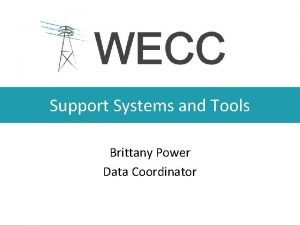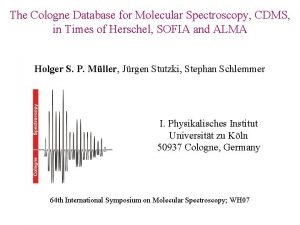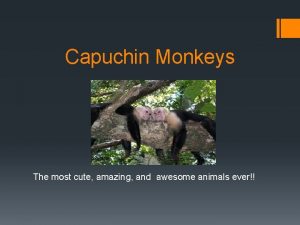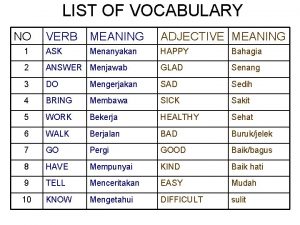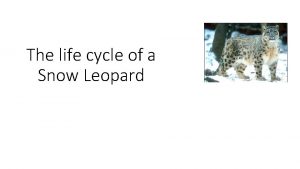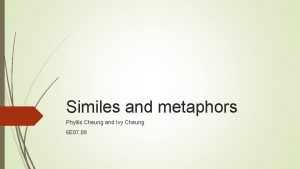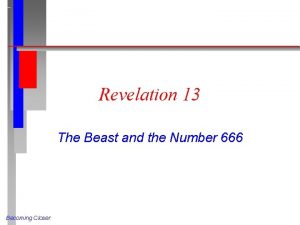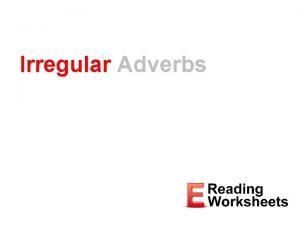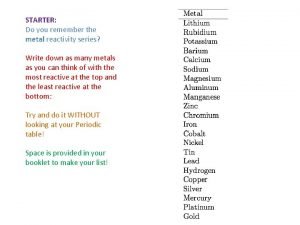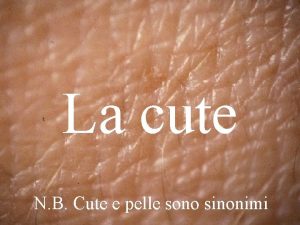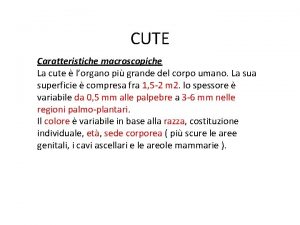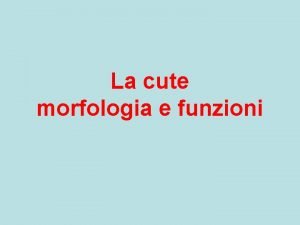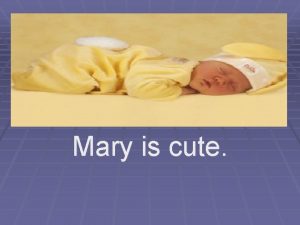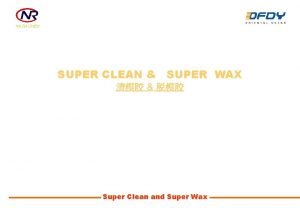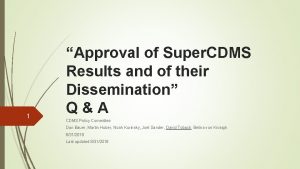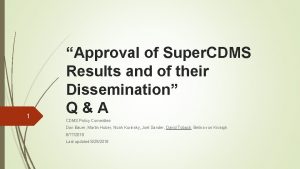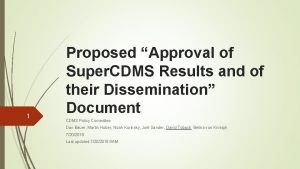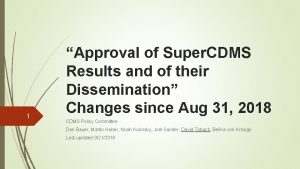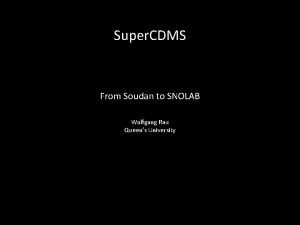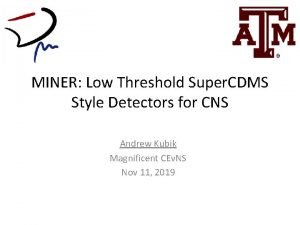Overview Super CDMS CUTE Analysis Super CDMS and














- Slides: 14

Overview Super. CDMS CUTE Analysis Super. CDMS and CUTE at SNOLAB Wolfgang Rau Queen’s University for the Super. CDMS Collaboration

Overview Super. CDMS CUTE Analysis Super. CDMS Analysis Projects CUTE Conclusions Detector technology Detector generations Experimental Setup Goals for SNOLAB Status Motivation Design Status Super. CDMS & CUTE – Wolfgang Rau – CAP Congress, Queen’s 05/17 Detector Calibration Backgrounds Rare interactions Dark Matter searches 2

Overview Super. CDMS CUTE Analysis Super. CDMS Collaboration California Institute of Technology CNRS/LPN Fermi National Accelerator Laboratory PNNL Queen’s University NISER University of Minnesota Northwestern University Texas A&M University of California, Berkeley University of Evansville University of South Dakota Super. CDMS & CUTE – Wolfgang Rau – CAP Congress, Queen’s 05/17 SLAC/KIPA SNOLAB/Laurentian University Stanford University of British Columbia/TRIUMF University of Colorado Denver NIST Santa Clara University South Dakota School of Mines & Technology Southern Methodist University Durham University of Florida University of Toronto

Overview Super. CDMS CUTE Analysis 4 Detectors Neganov-Luke Effect Super. CDMS Soudan Semiconductor operated at few 10 s of m. K + In Vacuum - Electron gains kinetic energy HV (E = q · V 1 e. V for 1 V potential) Phonon Readout: Tungsten TES i. ZIP - In Matter Add: charge readout (few V) Background discrimination Threshold < 10 ke. V Add: high voltage (~70 V) Deposited energy in crystal lattice: R vs T Phonons from drifting charges Neganov-Luke phonons Threshold < 0. 1 ke. V (phonon) + 0 remove surface background Charge signal - + Electron recoils: background 0 V V, # charges – large phonon + signal from charges – 70 V – 0 • Luke phonons mix charge and. Nuclear phonon signal reduced discrimination recoils: < 1 background event forvoltage large final phonon effectivecharge!! threshold: • Apply high signal, measures signal Phonon. NR signal whole • exposure few hundred e. V (NR) ER much more amplified than gain in threshold; dilute background from ER Super. CDMS & CUTE – Wolfgang Rau – CAP Congress, Queen’s 05/17

Overview Super. CDMS CUTE Detectors Analysis 5 Super. CDMS SNOLAB Ge / Si 100 mm x 33 mm Operated at 30 m. K HV i. ZIP Phonon Readout: Tungsten TES Add: charge readout (few V) Background discrimination Threshold < 1 ke. V R vs T Add: high voltage (~100 V) Phonons from drifting charges Threshold < 0. 1 ke. V (phonon) + 50 V remove surface background – 0 < 1 background event for whole exposure Charge signal + 0 Electron recoils: background – large phonon + signal from charges – 50 V Nuclear recoils: signal Phonon signal Super. CDMS & CUTE – Wolfgang Rau – CAP Congress, Queen’s 05/17 effective threshold: few (or one) electron-hole pairs

Overview Super. CDMS CUTE Analysis 6 Implementation (SNOLAB setup) Fridge to provide <15 m. K at the detector Detector volume (space for up to 31 “towers”) Initial Payload: 2 HV towers (4 Ge/2 Si) 1 Ge i. ZIP tower 1 Ge/Si i. ZIP tower (4/2) 6 detectors 1 tower 30 cm HDPE 20 cm Pb 60 cm HDPE base / water Cold finger Mounted on spring-loaded platform (seismic isolation) Super. CDMS & CUTE – Wolfgang Rau – CAP Congress, Queen’s 05/17 Signal vacuum feedthroughs Additional cooling (70 K/4 K)

Overview Super. CDMS CUTE Analysis 7 SNOLAB Clean room Access drift Experimental area Backup cooling (ice) Super. CDMS & CUTE – Wolfgang Rau – CAP Congress, Queen’s 05/17 Cryogenics and radon filter plant Cryo CUTE Radon filter

Overview Super. CDMS CUTE Analysis 8 Goal X LU 3 201 Long ter goal m Super. CDMS & CUTE – Wolfgang Rau – CAP Congress, Queen’s 05/17

Overview Super. CDMS CUTE Analysis 9 Schedule and Funding 2013 CFI approved CFI application 2014 2015 US G 2 decision 2016 CD 1 DOE/NSF proposals GW 1 2017 GW 2 a CAP 17 Queen’s 2018 2019 Main construction phase CD 2/3 CD 4 GW 2 Start of operation • Funding approved (CFI: 2012, DOE/NSF: 2014) • DOE/NSF review process: First step passed (CD 1: conceptual design review) Next step end of 2017: technical design review/ready for construction (CD 2/3) • Reviews at SNOLAB: passed Gateway 1 (space allocation) in fall 2015 / GW 2 a (early construction) in December 2016; upcoming: GW 2 (construction) fall 2017 • Total project costs ~$30 M Super. CDMS & CUTE – Wolfgang Rau – CAP Congress, Queen’s 05/17

Overview Super. CDMS CUTE Analysis 10 Developments (selection of activities) • Detectors: larger crystals; prototypes for both i. ZIP and HV detectors exist and have been tested using old electronics – good performance so far. Shielded transport • container Detector tower (mechanical structure, wiring): design ready, mechanical prototype exists; HV wiring prototype exists – final version expected soon. • Readout electronics: Preamp: thermal readout design ready; charge readout: circuits are being tested “Warm electronics” (outside cryostat): prototype exists, tests underway • DAQ: MIDAS based, being developed at UBC with help from TRIUMF and Uof. T [M. Wilson, POS-46] Underground polishing • Cryogenics design completed; shielding: design advanced, Dilution refrigerator is procured • Backgrounds: extensive material screening program; tracking and monitoring program; minimizing cosmogenic exposure for crystals; HV radon filter to be installed for detector assembly cleanroom at SNOLAB. Super. CDMS & CUTE – Wolfgang Rau – CAP Congress, Queen’s 05/17

Overview Super. CDMS CUTE Analysis 11 Cryogenic Underground TEst facility (CUTE) – a Queen’s Project Fridge: Motivation • Detector performance: Detector integrity after transportation Background discrimination Noise performance (impact of background) Pb Vibration damping <10 m. K • Background studies Confirm that screening program and handling procedures are appropriate Study cosmogenic backgrounds (3 H, 32 Si) Water Shield • Available for testing of other cryogenic detectors for rare event searches (e. g. EURECA detectors for integration with Super. CDMS) • Opportunity for early science! (BG O (few evt/ke. V/kg/d below 100 ke. V)) Schedule • • Cryostat ordered, to arrive at Queen’s this summer Infrastructure (water tank, platform, crane): ordered, installation starts in July Sept/Oct: test cryostat at Queen’s; installation underground end of 2017 Commissioning: early 2018 (~2 -3 years ahead of Super. CDMS) Super. CDMS & CUTE – Wolfgang Rau – CAP Congress, Queen’s 05/17

Overview Super. CDMS CUTE Analysis 12 Analysis Projects • Photo-Neutron calibration (low-energy nuclear recoil calibration); last “physics” measurement from Soudan (2015). Analysis under way (B. von Krosigk, UBC) • Backgrounds: Analysis of cosmogenic backgrounds in CDMSlite (3 H and others) Analysis in good shape; hope to publish this summer or fall (E. Fascione, Queen’s) • Rare interactions: follow-up of LIPs analysis (use CDMSlite data to improve our sensitivity for lower fractional charges? ) • Annual modulation – long time coming; hopefully ready within the next 2 -3 months • Standard WIMP search from Super. CDMS (full discrimination, intermediate to high mass range): not competitive with Xe for ‘vanilla WIMP’, but still important for more general models (EFT …); analysis essentially finished – publication in preparation • CDMSlite: detailed discussion of previous analysis [R. Underwood, POS-39] and incremental results (publication very soon) • Last CDMSlite data set – blinding scheme developed [X. Zhang, Thursday R 3 -4; 2: 30], consider background modeling; analysis ongoing (W. Page, D. Mac. Donell, UBC) • Test sensitivity of detectors to vibrations [R. Germond, POS-33] Super. CDMS & CUTE – Wolfgang Rau – CAP Congress, Queen’s 05/17

Overview Super. CDMS CUTE Calibration Analysis 13 Calibration Energy threshold in the e. V range: need new methods for low-energy calibration • Neutron activation: 70 Ge 71 Ge, EC (10. 4 ke. V, 1. 3 ke. V, 0. 16 e. V); doesn’t work for Si • Queen’s effort: use IR photons (long-term goal: single e-h pair measurement) Low energy scale by comparison of detectors close to and far from photon source [M. Ghaith, Monday M 4 -3] • Low energy nuclear recoil calibration: neutron scattering (TUNL, DD generator), γ recoils after thermal neutron capture Super. CDMS & CUTE – Wolfgang Rau – CAP Congress, Queen’s 05/17

Overview Super. CDMS CUTE Analysis 14 Conclusions • Super. CDMS SNOLAB aims at detecting dark matter WIMPs • Main focus are low-mass WIMPs (< 10 Ge. V/c 2) • Project planning well under way • Main R&D is done, full technical design close to completion • Start of operation expected in 2020 • Initial payload: ~30 kg, significant push in threshold and sensitivity • Upgrades (improved HV detectors, EURECA detectors, …) will allow us to reach the neutrino floor at low mass and/or check discovery claims at high mass • CUTE: Queen’s initiative for an underground test facility, operational in early 2018 (detector performance studies, background checks, early dark matter science) • Analysis: many updates in the pipeline; small steps until new facilities come online Super. CDMS & CUTE – Wolfgang Rau – CAP Congress, Queen’s 05/17
